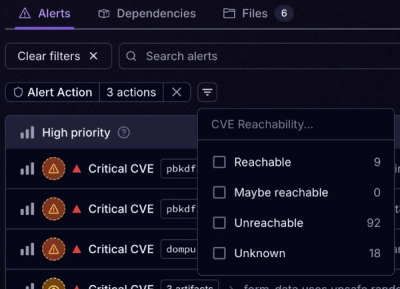
Product
Announcing Socket Fix 2.0
Socket Fix 2.0 brings targeted CVE remediation, smarter upgrade planning, and broader ecosystem support to help developers get to zero alerts.
webpivottable
Advanced tools
WPT component is a public github project for any one to download and try it
WPT component published as a npm package, you can install it by run:
npm install webpivottable
or
yarn add webpivottable
https://webpivottable.com/releases/latest/dist/wpt.js
Copy whole public directory into web server root is all we need, no depends on any other libs or frameworks.
To integrate WPT component, we only need import one javascript file into web page like below:
<script type="text/javascript" src="./dist/wpt.js"></script>
Then, we can put a "wpt-pivot-table" tag into page:
<body>
<div id="wpt-container">
<web-pivot-table />
</div>
</body>
That's all. Simple enough. Now we have a full functional WebPivotTable on web page.
List below is a sample html file:
<!DOCTYPE html>
<html lang="en">
<head>
<meta charset="utf-8">
<meta http-equiv="Content-type" content="text/html;charset=UTF-8">
<meta http-equiv="X-UA-Compatible" content="IE=edge,chrome=1">
<meta name="viewport" content="width=device-width,initial-scale=1">
<title>WebPivotTable Component</title>
<style type="text/css">
html, body, #wpt-container {width:100%;height:100%; padding:0; margin:0;}
</style>
<script type="text/javascript" src="./dist/wpt.js"></script>
</head>
<body>
<div id="wpt-container">
<web-pivot-table />
</div>
</body>
</html>
For cross domain file or olap access, wpt component default to use our demo server as proxy:
options: {
server: {
fileProxyEnabled: 1, // enable/disable file Proxy 1/0
fileProxy: 'http://demo.webpivottable.com/wpt/fileProxy', // Server proxy for cross domain file acess
fileTimeout: 30000,
xmlaProxyEnabled: 1, // enable/disable Xmla Proxy 1/0
xmlaProxy: 'http://demo.webpivottable.com/wpt/xmlaProxy', // Server proxy for cross domain xmla access
xmlaTimeout: 30000,
},
}
If you want to run a server proxy by your own, please copy server directory as a nodeJs application. or if you are using other back end technology (like java, php, .net), you can add a proxy endpoint into your backend services the same as services.js inside server directory have done.
But if you have no cross domain access, then you can disable those proxies in above options.
FAQs
A pure javascript pivot table and pivot chart component.
We found that webpivottable demonstrated a not healthy version release cadence and project activity because the last version was released a year ago. It has 1 open source maintainer collaborating on the project.
Did you know?

Socket for GitHub automatically highlights issues in each pull request and monitors the health of all your open source dependencies. Discover the contents of your packages and block harmful activity before you install or update your dependencies.

Product
Socket Fix 2.0 brings targeted CVE remediation, smarter upgrade planning, and broader ecosystem support to help developers get to zero alerts.

Security News
Socket CEO Feross Aboukhadijeh joins Risky Business Weekly to unpack recent npm phishing attacks, their limited impact, and the risks if attackers get smarter.

Product
Socket’s new Tier 1 Reachability filters out up to 80% of irrelevant CVEs, so security teams can focus on the vulnerabilities that matter.